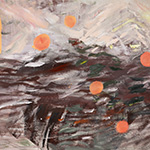“Ever since I started sculpting, I have made standing characters. In the beginning, they were small, and gradually grew taller. As soon as I touched clay, I wanted to create characters and therefore, standing men. … The way they visibly manifested comes from my archaeological background and my deep passion for my country and its history. For me, history begins with Sumer and has never ended. The form is alive for me; there is no point where history stops and changes. It’s a continuous moment.”
Simone Fattal
In her exhibition metaphorS, Simone Fattal presents bodies of work from different periods in her career and in a variety of media, including fired clay and ceramic sculptures, paintings, and collages. With her works, she tells stories of humanity, culture, history, and the present. Conflict, consensus, nature, faith, and trust are central concerns. Despite (or precisely because of) the artist’s nomadic life, her oeuvre is deeply rooted in the millennia-old culture and history of the Middle East—she was raised in Damascus and Beirut—and the epic literature, poetry, archaeology, and landscapes of this region, which is as rich as is riven by strife, are both vital sources of inspiration and central themes. Ancient-looking clay and ceramic sculptures are based on characters from prehistoric narratives like Gilgamesh, Dhat al-Himma, Dionysus, or Adam and Eve. Landscapes are the focus of her mostly abstract paintings, which are inspired by the view of Mount Sannine from Beirut, but also by the gardens of her childhood.
Simone Fattal studied in France and began painting in Beirut in the early 1970s. After years of civil war, she left Lebanon in 1980 and settled in California, where she founded the Post-Apollo Press; for the next thirty years, she dedicated herself to publishing literature and poetry, including many books by her partner Etel Adnan. In the late 1980s, she studied sculpture at the San Francisco Art Institute and fell in love with working with clay. Meanwhile, she also started making collages that combine pictures of archaeological sites and relics with contemporary photographs—fragmentation and conjunction underscoring the fragility of an identity shaped by migration. To recognize ruptures and affinities and weave their own associations and narratives, the artist says, the beholders should “read the collages slowly, like Persian or Arabic miniatures.”
Five large-format clay sculptures from the Guerriers series stand at the heart of the exhibition metaphorS. In a style that is characteristic of Fattal’s work, the unmistakably long-legged figures with their roughly treated surfaces—the material reveals traces of the hand-finished creative process—represent standing male characters: warriors, archetypal heroes, protectors. With their stout legs supporting small heads sitting on top almost seamlessly, the figures do not stand for specific individuals; rather, they are metaphors of human existence, of resistance and resilience. Created in the ceramic sculptor Hans Spinner’s studio in Grasse in the south of France in 2008, the ensemble is on public view for the very first time outside Lebanon, where it is part of the Saradar Collection, Beirut.
Besides a series of abstract paintings in small formats, Fattal shows two large landscapes titled Sitter I and II. The gestural-abstract depictions of a river scenery, painted when Fattal spent several weeks living and working at the Sitterwerk in St. Gallen, Switzerland, attest to her recently reawakened interest in the medium.
Simone Fattal was born in Damascus in 1942 and lived in Beirut and Sausalito, California, for many years. She now lives and works in Paris.
The publication accompanying the exhibition contains an interview with the curator Cecilia Alemani, who showcased Fattal’s art in the central exhibition of the Venice Biennale in 2022.
Programmed by the board of the Secession
Curated by Jeanette Pacher
Press release from Secession
Image: Simone Fattal. Sitter I. 2023. Oil on canvas. 160 x 274 x 3 cm. Photography by Flavio Karrer. Image courtesy of the artist and Karma International, Zurich



